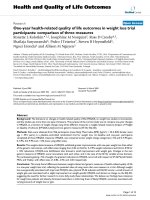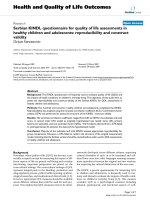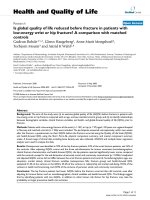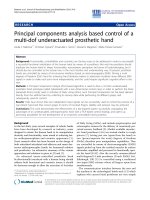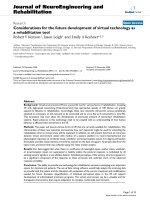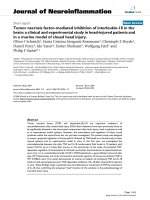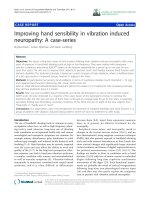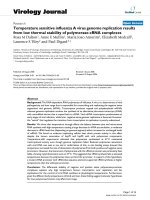Báo cáo hóa học: "Improving global influenza surveillance: trends of A(H5N1) virus in Africa and Asia" doc
Bạn đang xem bản rút gọn của tài liệu. Xem và tải ngay bản đầy đủ của tài liệu tại đây (541.58 KB, 18 trang )
This Provisional PDF corresponds to the article as it appeared upon acceptance. Fully formatted
PDF and full text (HTML) versions will be made available soon.
Improving global influenza surveillance: trends of A(H5N1) virus in Africa and
Asia
BMC Research Notes 2012, 5:62 doi:10.1186/1756-0500-5-62
Magdalena Escorcia ()
Marco Juarez Estrada ()
Matias S Attene-Ramos ()
Gerardo M Nava ()
ISSN 1756-0500
Article type Short Report
Submission date 31 August 2011
Acceptance date 23 January 2012
Publication date 23 January 2012
Article URL />This peer-reviewed article was published immediately upon acceptance. It can be downloaded,
printed and distributed freely for any purposes (see copyright notice below).
Articles in BMC Research Notes are listed in PubMed and archived at PubMed Central.
For information about publishing your research in BMC Research Notes or any BioMed Central
journal, go to
/>BMC Research Notes
© 2012 Escorcia et al. ; licensee BioMed Central Ltd.
This is an open access article distributed under the terms of the Creative Commons Attribution License ( />which permits unrestricted use, distribution, and reproduction in any medium, provided the original work is properly cited.
Improving global influenza surveillance:
trends of A(H5N1) virus in Africa and Asia
ArticleCategory :
Short Report
ArticleHistory :
Received: 31-Aug-2011; Accepted: 13-Dec-2011
ArticleCopyright
:
© 2012 Escorcia et al; licensee BioMed Central Ltd.
This is an Open Access article distributed under the terms of the
Creative Commons Attribution License
( which permits
unrestricted use, distribution, and reproduction in any medium,
provided the original work is properly cited.
Magdalena Escorcia,
Aff1
Email:
Matias S Attene-Ramos,
Aff2
Email:
Marco Juarez Estrada,
Aff1
Email:
Gerardo M Nava,
Aff3
Corresponding Affiliation: Aff3
Phone: +1-314-3624249
Fax: +1-314-3627487
Email:
Aff1
Departamento de Medicina y Zootecnia de Aves. Facultad de
Medicina Veterinaria y Zootecnia, Universidad Nacional Autónoma
de México. Ciudad Universitaria, Coyoacán, DF 04510, Mexico
Aff2
NIH Chemical Genomics Center, National Human Genome Research
Institute, NIH, 9800 Medical Center Drive, Rockville, MD 20850,
USA
Aff3
Dept. Pathology and Immunology, Washington University School of
Medicine, Box 8118, 660 S. Euclid Ave, St. Louis, MO 63110, USA
Abstract
Background
Highly pathogenic avian influenza A(H5N1) viruses are an important health problem in many
Asian and African countries. The current increase in human cases demonstrates that influenza
A(H5N1) is still a significant global pandemic threat. Many health organizations have
recognized the need for new strategies to improve influenza global surveillance. Specifically,
the World Health Organization through the global technical consultation for influenza
surveillance have called for a detailed picture of the current limitations, especially at the
nation level, to evaluate, standardize and strength reporting systems. The main goal of our
study is to demonstrate the value of genetic surveillance as part of a strategic surveillance
plan. As a proof of concept, we evaluated the current situation of influenza A(H5N1) in
Asian and Africa.
Results
Our analysis revealed a power-law distribution in the number of sequences of A(H5N1)
viruses analyzed and/or reported to influenza surveillance networks. The majority of the
Asian and African countries at great risk of A(H5N1) infections have very few
(approximately three orders of magnitude) sequenced A(H5N1) viruses (e.g. hemagglutinin
genes). This suggests that countries under pandemic alert for avian influenza A(H5N1) have
very limited participation (e.g. data generation, genetic analysis and data share) in avian
influenza A(H5N1) surveillance. More important, this study demonstrates the usefulness of
influenza genetic surveillance to detect emerging pandemic threat viruses.
Conclusions
Our study reveals that some countries suffering from human cases of avian influenza have
limited participation (e.g. genetic surveillance or data share) with global surveillance
networks. Also, we demonstrate that the implementation of genetic surveillance programs
could increase and strengthen worldwide epidemic and pandemic preparedness. We hope that
this work promotes new discussions between policy makers and health surveillance
organizations to improve current methodologies and regulations.
Findings
The recent outbreaks of highly pathogenic avian influenza A(H5N1) virus in numerous
countries in Asia and Africa and the increase in human cases, demonstrate that influenza A
viruses remain a global pandemic threat [1,2]. Worldwide, natural migrations of birds and
commercialization of poultry product are considered two of the most important mechanisms
of disease dispersion [3]. Due to the high risk of the A(H5N1) pandemic threat, multinational
efforts have been made to improve the surveillance and control of avian influenza viruses
around the world [4]. In recent years, important progress has been accomplished in the
standardization of laboratory techniques for the diagnostics of influenza viruses [5], and
phylogenetic nomenclature of highly pathogenic avian influenza A(H5N1) virus [6]. These
efforts have generated establishment of advanced global networks for influenza surveillance
[7].
In response to the 2009 influenza pandemic threat, the World Health Organization (WHO)
through the global technical consultation for influenza surveillance has called for a detailed
picture of current limitations in national reporting systems [8,9]. An important component of
the influenza surveillance system that deserves significant attention is the monitoring of
genetic and antigenic changes occurring in influenza viruses that circulate among human and
animals (e.g. [10,11]).
Genetic surveillance of influenza viruses have shown to be an essential tool for establishing
the gene origin of pandemic viruses, monitoring the status of an outbreak [11,12] and design
control strategies [13,14]. However, the regular use of genetic influenza surveillance remains
limited to only a few countries. Herein, we evaluate the extent of this problem and
demonstrate the importance of genetic surveillance during the current situation of highly
pathogenic avian influenza A(H5N1) virus in Asia and Africa. Given the significance of this
global pandemic threat, this study provides some basis to improve our current surveillance
programs.
Surveillance of avian influenza H5N1 virus in Asia and Africa
Information of human cases of avian influenza A(H5N1) reported to the WHO, were
retrieved from the Global Alert and Response (GAR) system [15]. This information has been
collected under WHO policies and regulations, and includes epidemiological data and
operational information about disease outbreaks. This system manages critical information
about outbreaks and accurate and timely communications between international public health
professionals [16]. A written consent (WHP-73,056) to extract and publish the data (number
human cases) was obtained from the WHO.
Avian influenza A(H5N1) have been reported in 15 countries (as of 25th March, 2011):
Azerbaijan, Bangladesh, Cambodia, China, Djibouti, Egypt, Indonesia, Iraq, Lao People’s
Democratic Republic, Myanmar, Nigeria, Pakistan, Thailand, Turkey and Viet Nam [15].
Because other countries in Asia, Africa and Europe are at prominent risk of influenza
outbreaks, the global network for influenza surveillance has implemented specific
surveillance polices for this region [7]. To gain insights into the current status and capacity of
influenza A(H5N1) surveillance in these countries, we analyzed the number of A(H5N1)
hemagglutinin (HA) sequences generated in national disease centers and universities as an
indicator of active surveillance. Analysis of influenza HA proteins is one of the most
important tools for global influenza surveillance network [2,17].
First, we examined the number of deposited HA sequences in the Influenza Virus Resource, a
comprehensive database integrating data from the National Institute of Allergy and Infectious
Diseases (NIAID), the J. Craig Venter Institute (JCVI) and GenBank at the National Center
for Biotechnology Information (NCBI) [18]. We retrieved and archived records for HA
sequences in Asian and African countries (all sequences available from different hosts and
environmental samples) of influenza A virus subtype H5N1 from 2003 to 2011 (as of 25th
March, 2011). A total of 2,934 HA sequences were found and retrieved from the database.
We found that the cumulative number of sequences for this period of time (2003–2011)
varied drastically between countries (Figure 1). The analysis revealed an approximation to a
power law distribution showing some degree of inequality between nations. For example,
most of the A(H5N1) sequences (73.7%) were obtained from a few number of countries
(China, Egypt, Vietnam, Thailand and Indonesia) and of the 36 Asian and African countries
that have performed genetic surveillance of HA proteins, 50% of them have deposited less
than 10 sequences in the database between 2003 and 2011 (Additional file 1).
Figure 1 Cumulative number of A(H5N1) hemagglutinin genes sequenced in Asian and
African countries and reported to influenza surveillance networks between 2003 and 2011
approximates a power law distribution (nonlinear power law regression, R
2
= 0.9066 and
Kolmogorov-Smirnov test P
< 0.0001 for lower, middle, and upper quartiles)
To verify the power law approximation in influenza genetic surveillance, we performed two
independent statistical tests. First, we ranked the countries by the number of available
sequences and then we fit the data to a nonlinear power law regression and a log-log plot
using GraphPad Prism 4 software, (GraphPad Prism, CA. USA). Second, we performed the
Kolmogorov-Smirnov test for goodness-of-fit to power law distributions [19] derived from
data variability using the lower (25th percentile), middle (50th percentile or median), and
upper (75th percentile) quartiles. This statistical analysis was carried out using StatView
software version 5.0.1. (SAS Institute, NC. USA). These analyses confirmed that HA gene
sequences archived in the in the Influenza Virus Resource have an approximation to a power
law distribution (nonlinear power law regression, R
2
= 0.9066 and Kolmogorov-Smirnov test
P < 0.0001 for lower, middle, and upper quartiles; Figure 2) demonstrating a strong
sequencing disproportion between nations. Together, these data suggest that some of the
selected nations have limited participation (e.g. data generation, genetic analysis and data
share) in the genetic surveillance of avian influenza A(H5N1) or a limited interaction with
global surveillance networks for data share. These observations highlight the need of new
polices to improve collaboration between nations affected by influenza outbreaks.
Figure 2 Power law distributions of the cumulative number of A(H5N1) hemagglutinin
genes sequenced in Asian and African countries and reported to influenza surveillance
networks between 2003 and 2011 (data shown in Figure 1) The 36 countries were ranked by
the number of reported gene sequences to the influenza surveillance network and plotted
against the total number of sequences. A) The data was fit to a nonlinear power law
regression and the coefficients were estimated. B) Log-Log plot (same dataset) showing a
linear regression. C) Kolmogorov-Smirnov test for goodness-of-fit to power law distributions
derived from data variability using the lower, middle (median), and upper quartiles
Second, to evaluate the trends of influenza genetic surveillance in countries under current
avian influenza A(H5N1) outbreaks in humans, we examined the number of reported HA
sequences from the 15 countries with avian influenza A(H5N1) disease cases and deaths (as
of 25th March, 2011) [15]. Our analysis demonstrated that between the years 2003 and 2011,
nations such as China, Egypt, Indonesia, Thailand and Viet Nam have performed a constant
A(H5N1) genetic surveillance (Figure 3). Intriguingly, we observed instances of lack of
A(H5N1) genetic surveillance even when human cases and deaths took place (e.g. Indonesia
2008, 2010, 2011 and Egypt 2011; Viet Nam 2009, Cambodia 2009, 2010, 2011). These
results indicated that in many instances, genetic analysis of influenza A(H5N1) is used as a
Ad hoc strategy rather than a surveillance method. Moreover, our results also demonstrate
that genetic surveillance of influenza viruses is performed by disease control centers and
research institutions with a limited number of sequences per year (e.g. Cambodia, 37 HA
sequences in 8 year period).
Figure 3 Trends of influenza genetic surveillance in countries under current avian influenza
A(H5N1) outbreaks in humans (disease cases and deaths). Number of reported A(H5N1)
hemagglutinin sequences from the 15 countries with avian influenza A(H5N1) cases and
deaths (as of 25th March, 2011) [12]. G = Genetic surveillance [A(H5N1) hemagglutinin
sequences]. C = Human cases of influenza A(H5N1). D = Human deaths caused by
A(H5N1). Red and yellow cells denote highest and lowest values. Scale: dark-red (highest)
and light-yellow (lowest). Source: data extracted from WHO-Global Alert and Response
(://www.who.int/csr/disease/avian_influenza/country/cases_table_2011_03_25/en/index.html
) with the written consent of the World Health Organization. *Lao People’s Democratic
Republic
To demonstrate that some countries suffering from human cases of avian influenza have
limited participation (i.e. genetic surveillance or data share) with global surveillance
networks, we estimated the ratios between total number of avian influenza A(H5N1) HA
sequences and total number of human cases of influenza A(H5N1) (data collected between
2003 and 2011, as shown in Figure 3). This analysis revealed significant differences
(P ≤ 0.016) in sequencing capability between countries (Figure 4). For example, in Nigeria
171 A(H5N2) genes were sequenced per human case; in contrast, in Azerbaijan only 0.6
genes were sequenced per human case. These numbers represent a 285 fold difference
between these two countries. Together, these findings also indicate that some nations have
limited participation in the genetic surveillance of avian influenza A(H5N1) or a limited
interaction with global surveillance networks for data share. This problem was recently
recognized by the WHO global technical consultation for influenza surveillance. This group
of experts identify that the Ad hoc surveillance strategy is easy to use but is least desirable
because results are biased depending on sampling approach [8]. Together, these observations
reaffirm the need of new policies in influenza surveillance to improve country coverage and
sampling prioritization.
Figure 4 Ratios between total number of avian influenza A(H5N1) HA sequences and the
total number of human cases of influenza A(H5N1) (data between 2003 and 2011 as shown
in Figure 3). This analysis revealed significant differences between countries. The ratio
difference between Nigeria and Azerbaijan represent a 285 fold difference. Statistical
analysis was performed by means of Kolmogorov-Smirnov test for goodness-of-fit to power
law distributions using lower (P = 0.0025), middle (P = 0.0011), and upper (P = 0.0165)
quartiles
We recognize that our assessment has been restricted to the genetic surveillance of A(H5N1)
viruses and data deposition in influenza global networks, and that serological surveillance
may occur in some of these countries. Nevertheless, the main goal of our analysis is to
illustrate the current situation of some nations facing the risk of human influenza outbreaks
and their involvement with the global influenza surveillance network.
These observations emphasize the need of new polices to improve genetic surveillance and
data share for influenza surveillance. For example, a better distribution of financial and
technical sources among affected nations. To demonstrate the importance of implementing
genetic analysis and surveillance networks, we performed a retrospective and comprehensive
genetic analysis of influenza A(H5N1) viruses in these 15 Asia and Africa countries. We
analyzed A(H5N1) genetic diversity between years 2000 and 2011. A total of 2,757
sequences (as of 25th March, 2011) were retrieved from the Influenza Virus Resource at the
NCBI [18]. After removing duplicated and partial protein sequences, 1,446 HA sequences
were aligned using MUSCLE software [20], manually inspected for quality and trimmed to
equal length. Aligned sequences were used for genetic analysis using the minimum evolution
method [21]. Analysis were performed using the MEGA4 [22] and Seaview [23] software.
The statistical significance of branch order was estimated by the generation of 50 replications
of bootstrap re-sampling of the originally-aligned nucleotide sequences.
The genetic analysis of HA proteins from influenza A(H5N1) viruses circulating between
2000 and 2011 in the selected Asian and African countries, revealed that A(H5N1) viruses
clustered by country and year of isolation indicating that this virus follows regional and
annual trends (Figure 5). Also, the analysis revealed that viruses circulating in China are
highly diverse, supporting the idea that this region represents an important source of highly
diverse pathogenic H5N1 avian influenza viruses [24]. For example, viruses circulating in
China between 2000 and 2003 are genetic similarity to those circulating in Cambodia,
Vietnam and Laos in the period between 2004 and 2007, and in Bangladesh between 2007
and 2010 (e.g. Figure 5, cluster A). In many countries, recent (2008–2011) A(H5N1) viral
isolates have close homology to viruses circulating in the period between 2004 and 2007 (e.g.
Figure 5; genotype II). More important, our genetic surveillance method was able to identify
A(H5N1) viruses with genetic distinctness, an important trait of novel and potentially
pandemic influenza viruses [12]. Together, these results highlight the value of genetic
surveillance to accurately indentify genetic differences between influenza viruses that
circulate among humans and animals, a key factor for the development of vaccines, outbreak
preparedness, and pandemic planning (e.g. [10-13,25,26]).
Figure 5 The genetic diversity and distinctiveness of influenza A(H5N1) viruses circulating
between 2003 and 2011 in Asian and African countries. Filled circles depict viruses isolated
in 2010–2011
To corroborate our observations, we examined the origin of the viruses with genetic
distinctiveness. Genotype I (e.g. Viet Nam 2005, accession numbers ABD14806 and
ABD14808) includes highly pathogenic viruses isolated from shell washes of duck and goose
eggs confiscated from travelers. These viruses have close homology to a Hong Kong 97-like
H5N1 influenza virus [27]. Genotype II (e.g. Viet Nam isolates from 2008 to 2011,
ACO07034, ACO07035, ACO07036 and ACO07037) includes highly pathogenicity and
exotic H5N1 viruses isolated from poultry seized at a port of entry into Viet Nam [28].
Genotype III (e.g. China 2006, ADG59089), an exotic virus generated through multiple
reassortment events isolated in China. Importantly, viruses with close HA protein homology
to genotype III, reacted poorly with antisera produced from other viruses circulating in China.
Based on these observations, these viruses were cataloged as a pandemic threat [29].
Genotype IV (e.g. Egypt 2008, ADG28679; and 2010, ADM85867, ADM85879) includes
recent isolates of highly pathogenicity avian influenza A(H5N1) viruses circulating in Egypt.
Genotype V (USA 2007, ACZ36900 and ACZ48494) represents A(H5N1) sequences used to
validate the efficacy of this genetic analysis to detect exotic genotypes. Genotype VI (e.g.
Viet Nam 2008, ACY06607, ACY06606, ACO07033 and ADF83652) integrated by high
pathogenicity A(H5N1) viruses isolated from chickens seized at ports of entry in Viet Nam
[30]. These viruses were antigenically distinct from contemporary strains circulating in Viet
Nam. This genotypic group also included A(H5N1) viruses isolated from humans possessing
unknown virulence determinants involved in high pathogenicity [31]. Together, these
analyses reveal the value of genetic surveillance to identify potential influenza pandemic
threats circulating in specific global regions.
The influenza pandemic in 2009 highlighted the need of an improved global surveillance
system. Specifically, the last pandemic event showed the technical challenges that many
nations face to monitor influenza outbreaks when standardized surveillance and reporting
system are not established [8]. Significant efforts have been taken by independent research
groups and the WHO to revise and standardize methodologies for data collection and
reporting systems. However, these challenges are very complex in nature and many of them
remain ambiguous. For example, the WHO global technical consultation for influenza
surveillance and other WHO influenza program experts recently indentify that the lack of
standardization in surveillance methods results in data sets that are not comparable between
nations and that the data cannot be compiled to generate a comprehensive picture of the virus
spread between nations [8]. To this end, our study clearly documents this issue. Here, we
have shown that many countries where highly pathogenic avian influenza A(H5N1) virus
represents a current pandemic threat, have a limited participation (e.g. data generation,
genetic analysis and data share) in avian influenza A(H5N1) surveillance. Although we
cannot provide conclusive evidence explaining these national trends, we presume that this
issue could be linked to the fact that some nations lack technical sources to perform the
surveillance, lack an effective mechanism for reporting surveillance data, have limited human
sources (trained personnel, problems with internet connectivity, etc.) or are influenced by
political pressures [8].
Importantly, the WHO global technical consultation for influenza surveillance has also called
for the description of a detailed picture of the current limitations, especially at the nation level
[8,9]. With this in mind, here we provide some bases to establish a strategy to overcome
some of these limitations and enhance influenza surveillance. Specifically, our analysis
demonstrates that implementation of genetic surveillance programs could strengthen
worldwide epidemic and pandemic preparedness. For example, our study revealed that
A(H5N1) viruses clustered by country and year of isolation indicating that this virus follows
regional and annual trends. Also, our analysis identified highly diverse (exotic) viruses co-
circulating with endemic viruses. Based on these results, we propose that genetic surveillance
system should be a key component of influenza surveillance. In particular, we believe that
genetic surveillance can be adopted worldwide even in less-resourced areas. This idea is
supported by studies demonstrating that a few genetic sequences (less than 50 HA genes
sequenced) are sufficient to effectively track the antigentic changes occurring in influenza
viruses circulating in specific geographical locations and over a period of 5–10 years [13,25].
We hope the present study stimulates further studies and discussions to accelerate the
improvement of guidance and recommendations for influenza surveillance.
In summary, the significance of the present study is at least three fold. First, it is revealed that
in many countries under current pandemic alert for avian influenza A(H5N1), there is a
limited genetic surveillance of influenza A(H5N1) viruses. This is due apparently to a limited
participation (e.g. data generation, genetic analysis and data share) in avian influenza
A(H5N1) surveillance. Second, analysis of national surveillance trends revealed that genetic
analysis of influenza viruses occurred in many cases as Ad hoc strategy but not as a
surveillance technique (prevention). Third, it is demonstrated the usefulness of influenza
genetic surveillance to detect pandemic threat viruses. The significance of this molecular
approach was demonstrated in the past A(H1N1) 2009 world pandemic, in which genetic
analyses were essential to establish the origin of the new reassortant virus [11,12]. Finally,
and perhaps more important, it is worrying that the majority of countries suffering from
human cases of avian influenza have a limited access to genetic surveillance, even though
this method is very effective to detect exotic and highly divergent circulating between
humans, wild and farm animals. We wish that this work promotes new discussions between
policy makers and health surveillance organizations to improve current methodologies and
regulations.
Abbreviations
WHO, World Health Organization; GAR, Global Alert and Response; HA, Hemagglutinin;
NIAID, National Institute of Allergy and Infectious Diseases; JCVI, The J. Craig Venter
Institute; NCBI, The National Center for Biotechnology Information.
Author contributions
G.M.N., M.E., M.J.E. and M.S.A.R. designed research and performed research; G.M.N.,
M.E. and M.S.A.R. wrote the paper. All authors read and approved the final manuscript.
Competing interests
The author(s) declare that they have no competing interests.
Acknowledgements and Funding
This work was supported (or partially supported) by the program UNAM-DGAPA-PAPIIT,
project number IN201110. Also, we thank the World Health Organization Press, Office of
Permissions Management and Reprint Rights for granting permission to extract and
reproduce data from the Global Alert and Response. Also, we thank Dr. Irene Hanning-
Jarquin for comments on the manuscript.
References
1. FAO_Avian_Influenza: The fight against HPAI in Cambodia continues. In: The Food
and Agriculture Organization
(http://wwwfaoorg/avianflu/en/news/cambodia_hpaihtml). 2011.
2. WHO_Avian_Influenza: Global Alert and Response-Avian Influenza
(
3. Gibbs SE: Avian biology, the human influence on global avian influenza transmission,
and performing surveillance in wild birds. Anim Health Res Rev 2010, 11(1):35–41.
4. FAO_Avian_Influenza: The Food and Agriculture Organization, Strategy and Policy
documents (
5. Charlton B, Crossley B, Hietala S: Conventional and future diagnostics for avian
influenza. Comp Immunol Microbiol Infect Dis 2009, 32(4):341–350.
6. WHO/OIE/FAO_H5N1_Evolution_Working_Group: Toward a unified nomenclature
system for highly pathogenic avian influenza virus (H5N1). Emerg Infect Dis 2008,
14(7):e1.
7. WHO_Influenza: WHO Global Influenza Virological Surveillance
(
8. WHO: WHO global technical consultation: global standards and tools for influenza
surveillance
( />ml). In.; 2011.
9. Briand S, Mounts A, Chamberland M: Challenges of global surveillance during an
influenza pandemic. Public Health 2011, 125(5):247–256.
10. Smith GJ, Fan XH, Wang J, Li KS, Qin K, Zhang JX, Vijaykrishna D, Cheung CL,
Huang K, Rayner JM et al: Emergence and predominance of an H5N1 influenza variant
in China. Proc Natl Acad Sci U S A 2006, 103(45):16936–16941.
11. Smith GJ, Vijaykrishna D, Bahl J, Lycett SJ, Worobey M, Pybus OG, Ma SK, Cheung
CL, Raghwani J, Bhatt S et al: Origins and evolutionary genomics of the 2009 swine-
origin H1N1 influenza a epidemic. Nature 2009, 459(7250):1122–1125.
12. Nava GM, Attene-Ramos MS, Ang JK, Escorcia M: Origins of the new influenza
A(H1N1) virus: time to take action. Euro Surveill 2009, 14(22):19228.
13. Escorcia M, Carrillo-Sanchez K, March-Mifsut S, Chapa J, Lucio E, Nava GM: Impact
of antigenic and genetic drift on the serologic surveillance of H5N2 avian influenza
viruses. BMC Vet Res 2010, 6:57.
14. Garten RJ, Davis CT, Russell CA, Shu B, Lindstrom S, Balish A, Sessions WM, Xu X,
Skepner E, Deyde V et al: Antigenic and genetic characteristics of swine-origin 2009
A(H1N1) influenza viruses circulating in humans. Science 2009, 325(5937):197–201.
15. WHO_Avian_Influenza: Cumulative Number of Confirmed Human Cases of Avian
Influenza A/(H5N1) Reported to WHO
( />ex.html)
16. Global_Alert_and_Response: Alert and response operations
(
17. WHO_Avian_Influenza: Collecting, preserving and shipping specimens for the
diagnosis of avian influenza A(H5N1) virus infection. Guide for field operations
( />06_1/en/index.html)
18. Bao Y, Bolotov P, Dernovoy D, Kiryutin B, Zaslavsky L, Tatusova T, Ostell J, Lipman
D: The influenza virus resource at the National Center for Biotechnology Information. J
Virol 2008, 82(2):596–601.
19. Goldstein ML, Morris SA, Yena GG: Problems with fitting to the power-law
distribution. Eur Phys J B 2004, 41:255–258.
20. Edgar RC: MUSCLE: multiple sequence alignment with high accuracy and high
throughput. Nucleic Acids Res 2004, 32(5):1792–1797.
21. Rzhetsky A, Nei M: Theoretical foundation of the minimum-evolution method of
phylogenetic inference. Mol Biol Evol 1993, 10(5):1073–1095.
22. Tamura K, Dudley J, Nei M, Kumar S: MEGA4: Molecular Evolutionary Genetics
Analysis (MEGA) software version 4.0. Mol Biol Evol 2007, 24(8):1596–1599.
23. Gouy M, Guindon S, Gascuel O: SeaView version 4: a multiplatform graphical user
interface for sequence alignment and phylogenetic tree building. Mol Biol Evol 2010,
27(2):221–224.
24. Wu B, Wang C, Dong G, Guo Y, Nolte DL, Deliberto TJ, Xu J, Duan M, He H: New
evidence suggests Southern China as a common source of multiple clusters of highly
pathogenic H5N1 avian influenza virus. J Infect Dis 2010, 202(3):452–458.
25. Escorcia M, Vazquez L, Mendez ST, Rodriguez-Ropon A, Lucio E, Nava GM: Avian
influenza: genetic evolution under vaccination pressure. Virol J 2008, 5:15.
26. Vijaykrishna D, Poon LL, Zhu HC, Ma SK, Li OT, Cheung CL, Smith GJ, Peiris JS,
Guan Y: Reassortment of pandemic H1N1/2009 influenza a virus in swine. Science 2010,
328(5985):1529.
27. Li Y, Lin Z, Shi J, Qi Q, Deng G, Li Z, Wang X, Tian G, Chen H: Detection of Hong
Kong 97-like H5N1 influenza viruses from eggs of Vietnamese waterfowl. Arch Virol
2006, 151(8):1615–1624.
28. Nguyen T, Davis CT, Stembridge W, Shu B, Balish A, Inui K, Do HT, Ngo HT, Wan
XF, McCarron M et al: Characterization of a highly pathogenic avian influenza H5N1
virus sublineage in poultry seized at ports of entry into Vietnam. Virology 2009,
387(2):250–256.
29. Coker RJ, Hunter BM, Rudge JW, Liverani M, Hanvoravongchai P: Emerging
infectious diseases in southeast Asia: regional challenges to control. Lancet 2011,
377(9765):599–609.
30. Davis CT, Balish AL, O’Neill E, Nguyen CV, Cox NJ, Xiyan X, Klimov A, Nguyen T,
Donis RO: Detection and characterization of clade 7 high pathogenicity avian influenza
H5N1 viruses in chickens seized at ports of entry and live poultry markets in Vietnam.
Avian Dis, 54(1 Suppl):307–312.
31. Le QM, Ito M, Muramoto Y, Hoang PV, Vuong CD, Sakai-Tagawa Y, Kiso M, Ozawa
M, Takano R, Kawaoka Y: Pathogenicity of highly pathogenic avian H5N1 influenza a
viruses isolated from humans between 2003 and 2008 in northern Vietnam. J Gen Virol,
91(Pt 10):2485–2490.
Additional files
Additional_file_1 as PDF
Additional file 1 Additional table. Cumulative number of A(H5N1) hemagglutinin genes
sequenced in Asian and African countries and reported to influenza surveillance networks
between 2003 and 2011.
700
800
600
uences
400
500
ve number of seq
200
300
Cumulati
0
100
Figure 1
A
B
Y=A*X^B
A= 798.1 46.43
B=-0.9736 0.06032
R
2
= 0.9066
A
Y=B*X+ A
A= 3.608
0.1341
B= -2.103
0.1105
R
2
= 0.9142
B
95% Confidence Intervals:
A: 703.6 to 892.5
B: -1.096 to -0.8509
B
DF
2
DF
2
DF
2
Kolmogorov-Smirnov Test for low er
quartile (25th percentile)
Kolmogorov-Smirnov Test for middle
quarti le (50th percenti le)
Kolmogorov-Smirnov Test for upper
(75th percenti l e) quartile
DF
2
DF
2
DF
2
Count, A 26 Count, A 18 Count, A 9
Count, B 10 Count, B 18 Count, B 27
Maximum Difference 1 Maximum Difference 1 Maximum Difference 1
Chi Square 28.889 Chi Square 36 Chi Square 27
PV l
00001
PV l
00001
PV l
0 0001
P
-
V
a
l
ue <
0
.
0001
P
-
V
a
l
ue <
0
.
0001
P
-
V
a
l
ue <
0
.
0001
Figure 2
Country G C D G C D G C D G C D G C D G C D G C D G C D G C D
Indonesia
1500270072201313455451842370242012119097033
Egypt
00000010054181010225989841133945829130114
Viet Nam
1933111292012461199001068529650551572000
China
56
1
1
84
0
0
263
8
5
282
13
8
34
5
3
11
4
4
6
7
4
0
2
1
0
0
0
2010 20112003 2004 2005 2006 2007 2008 2009
China
56
1
1
84
0
0
263
8
5
282
13
8
34
5
3
11
4
4
6
7
4
0
2
1
0
0
0
Thailand
00020517128052183310001700000000000
Cambodia
00030014441622311110010011033
Turkey
0000003001521242100400000000000
Azerbaijan
000000000585000000000000000
Iraq
0000000001032000000000000000
Pakistan
0
0
0
0
0
0
0
0
0
3
0
0
7
3
1
0
0
0
0
0
0
0
0
0
0
0
0
Pakistan
0
0
0
0
0
0
0
0
0
3
0
0
7
3
1
0
0
0
0
0
0
0
0
0
0
0
0
Bangladesh
00000000000013001410100300010
Laos*
00030000080022221000000000000
Djibouti
000000000110000000000000000
Myanmar
000000000100310000000000000
Nigeria
000000000105006411210000000000
Number of reported A(H5N1) hemagglutinin sequences from the 15 countries with avian influenza A(H5N1) cases and deaths (as of 25th March, 2011) [12].
G = Genetic surveillance [A(H5N1) hemagglutinin sequences].
C = Human cases of influenza A(H5N1).
D = Human deaths caused by A(H5N1).
Red and yellow cells denote highest and lowest values. Scale: dark-red (highest) and light-yellow (lowest).
Source: data extracted from WHO-Global Alert and Response (
with the written consent of the World Health Organization
with
the
written
consent
of
the
World
Health
Organization
.
*Lao People's Democratic Republic.
Figure 3
s
es
171.0
160
180
m
ber of human ca
s
120
140
o
f sequences/nu
m
80
100
Ratio = number
o
21.5
18.4
15.0
14.0
13.2
20
40
60
4.0
3.3
3.3 3.3
2.8
2.8
1.5
1.0
0.6
0
Figure 4
Genotype I
Gt VI
Genotype II
G
eno
t
ype
VI
Cluster A
Azerbaijan
Bangladesh
Cambodia
China
Genotype V
Egypt
Indonesia
Iraq
Laos
Myanmar
Nigeria
Pakistan
4222
/
4225
Thailand
Turkey
Viet Nam
4222
"
/
4225
4226"/ 4229
422:"/ 4233
Genotype III
igpgvke"fkuvkpevpguu"*""""+
0.01
Genotype IV
Figure 5
Additional files provided with this submission:
Additional file 1: Additional File 1.pdf, 17K
/>
